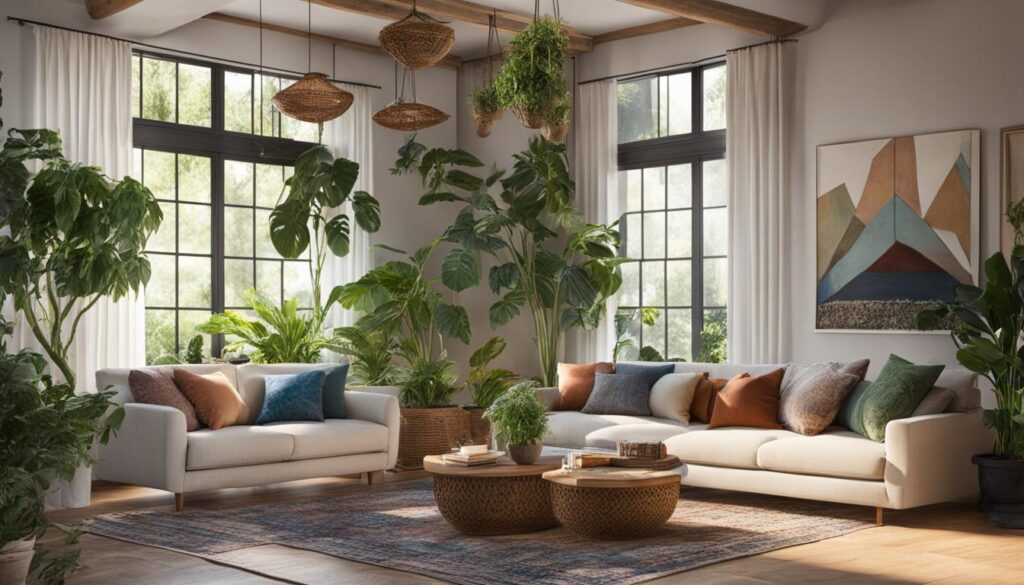Decorating with plants is a popular and effective way to enhance the aesthetics of your living room while bringing life and vitality to the space. Indoor plants come in a vast variety of options, allowing you to choose plants that fit the style and atmosphere you want to create. Plants not only add beauty to the room but also provide numerous health benefits, such as improving air quality and reducing stress. To successfully decorate your living room with plants, it’s important to choose the right plants that thrive in the indoor environment and arrange them in a way that complements your existing decor.
Table of Contents
Key Takeaways:
- Decorating with plants adds beauty and vitality to your living room.
- Indoor plants improve air quality and reduce stress.
- Choose plants that thrive indoors and complement your existing decor.
- Arranging plants in odd numbers and varying heights, textures, and colors creates visual interest.
- Proper care and watering are essential for the health and longevity of your plants.

Benefits of Decorating with Plants
Decorating your living room with plants offers numerous benefits. Not only do plants add visual appeal and create a relaxing and inviting atmosphere, but they also have positive effects on our health and well-being.
Indoor plants have the ability to purify the air, remove toxins, and increase humidity, creating a healthier environment for you and your family. Studies have shown that having indoor greenery for living room can improve air quality by reducing the levels of pollutants such as formaldehyde, benzene, and trichloroethylene.
Furthermore, plants can also help to reduce stress and promote a sense of well-being. Caring for plants can be a mindful and therapeutic activity, allowing you to connect with nature and find moments of calm in your busy day. Indoor plant decorating ideas can transform your living room into a peaceful sanctuary, providing a natural escape from the hectic outside world.
“Bringing plants into your living room can not only enhance the aesthetics of the space but also improve your overall health and well-being.” – Interior Designer
Whether you have a small living room or a spacious area to work with, there are plenty of plant decor options that can fit your space and style. From hanging planters and vertical gardens to small potted plants and terrariums, there are endless possibilities for incorporating indoor plants into your living room decor. The key is to choose plants that thrive in your specific living room conditions, such as low-light plants for rooms with limited natural light or succulents for spaces with plenty of sunlight.
| Benefits of Decorating with Plants | Indoor Greenery for Living Room | Plant Decor for Small Living Room | Indoor Plant Decorating Ideas |
|---|---|---|---|
| Improves air quality | Enhances aesthetics | Maximizes limited space | Brings nature indoors |
| Reduces stress | Promotes well-being | Creates a peaceful atmosphere | Adds a touch of greenery |
| Increases humidity | Connects with nature | Provides a natural escape | Offers a sense of tranquility |
Benefits of Decorating with Plants:
- Improves air quality
- Reduces stress
- Increases humidity
In conclusion, decorating your living room with plants not only adds beauty and style to the space, but it also provides a range of benefits for your health and well-being. Whether you have a small living room or a larger area to work with, incorporating greenery into your decor can create a peaceful and inviting atmosphere. So why not bring a touch of nature indoors and enjoy the many benefits of decorating with plants?
Tips for Arranging Plants in the Living Room
When it comes to arranging plants in your living room, there are a few key tips to keep in mind. These strategies will help you create a visually appealing and harmonious display that complements your existing decor and enhances the overall atmosphere of the room.
Vary Heights, Textures, and Colors
One of the most important aspects of arranging plants in your living room is to vary the heights, textures, and colors of the plants. This creates visual interest and adds depth to the space. Place taller plants in the back or corners of the room, and shorter plants on tables or shelves. Mix plants with different leaf shapes and textures, such as broad, glossy leaves with delicate, feathery foliage. Consider the color palette of your living room and choose plants with leaves or flowers that complement the existing decor.
Group Plants in Odd Numbers
The rule of three is a useful guideline when arranging plants in your living room. Grouping plants in odd numbers, such as three or five, creates a more natural and visually pleasing arrangement. This technique adds balance and symmetry to the space, creating a sense of harmony. Place the grouped plants on a side table, a windowsill, or a plant stand to create a focal point in the room.
Consider Lighting Conditions
When choosing plants for your living room, it’s important to consider the lighting conditions in the space. Some plants thrive in bright, direct sunlight, while others prefer low to moderate light. Place plants that need lots of sunlight near windows or in areas with ample natural light. For plants that prefer low light, choose spots away from windows or use artificial lighting to provide adequate illumination. By selecting plants that match the lighting conditions in your living room, you’ll ensure their health and longevity.
By following these tips, you can create a beautiful and inviting arrangement of plants in your living room. Remember to vary heights, textures, and colors, group plants in odd numbers for visual appeal, and consider the lighting conditions in the space. With these strategies in mind, you’ll be able to create a stunning display that enhances the aesthetics of your living room while bringing the benefits of indoor plants into your home.

| Tip | Description |
|---|---|
| Vary Heights, Textures, and Colors | Create visual interest by mixing plants with different heights, leaf textures, and colors. |
| Group Plants in Odd Numbers | Arrange plants in groups of three or five to achieve a natural and visually pleasing display. |
| Consider Lighting Conditions | Select plants that thrive in the available light, whether it’s bright and direct or low and indirect. |
Conclusion
Finally, adding plants to your living area adds beauty, practicality, and nature. By choosing and placing indoor plants wisely, you may create a harmonious and attractive living area that improves air quality and aesthetics.
Indoor plant décor options are plentiful, so you may select plants that match your style and fit your living area, regardless of size. No matter your environment, there are many ways to decorate with plants.
Consider these techniques when arranging living room plants. Arrange plants in odd numbers using the rule of three for a more natural look. Create depth and intrigue with plant heights, textures, and colors. Take into account lighting and choose plants that grow there. To keep your plants healthy and long-lived, water and care for them as needed.
Decorating with plants may revitalize your living area and improve your health. Simple and efficient, it turns your room into a vivid and inviting refuge you’ll like spending time in.
FAQ
How can I decorate my living room with plants?
To decorate your living room with plants, choose plants that fit the style and atmosphere you want to create. Consider the lighting conditions in your living room and choose plants that thrive in the available light. Vary the heights, textures, and colors of your plants to create depth and interest. Utilize different types of planters and containers to add variety and style to your arrangement.
What are the benefits of decorating with plants?
Decorating your living room with plants not only adds visual appeal and creates a relaxing atmosphere but also has positive effects on your health and well-being. Indoor plants can purify the air, remove toxins, increase humidity, and create a healthier environment. Caring for plants can also be a mindful and therapeutic activity, reducing stress and promoting a sense of well-being.
How should I arrange plants in my living room?
When arranging plants in your living room, consider using the rule of three, grouping plants in odd numbers for a more natural and visually pleasing arrangement. Vary the heights, textures, and colors of your plants to create depth and interest. Be mindful of the lighting conditions in your living room and choose plants that thrive in the available light. Consider the growth habits of the plants and how they can complement the existing furniture and decor. Utilize different types of planters and containers to add variety and style to your arrangement.
How can I incorporate indoor plants into a small living room?
If you have a small living room, there are still plenty of ways to incorporate indoor plants into your decor. Opt for smaller plants or choose hanging plants to save space. Use vertical space by placing plants on shelves or using wall-mounted planters. Consider using multipurpose furniture, such as plant stands that double as storage or side tables. Select plants with compact growth habits that won’t overwhelm the space.
What are the best plants for a living room?
The best plants for a living room are those that thrive indoors and fit the available lighting conditions. Some popular choices include pothos, snake plant, spider plant, peace lily, and ZZ plant. These plants are known for their ability to purify the air and require minimal maintenance. However, the best plants for your living room will depend on your specific lighting conditions, space, and personal preferences.


